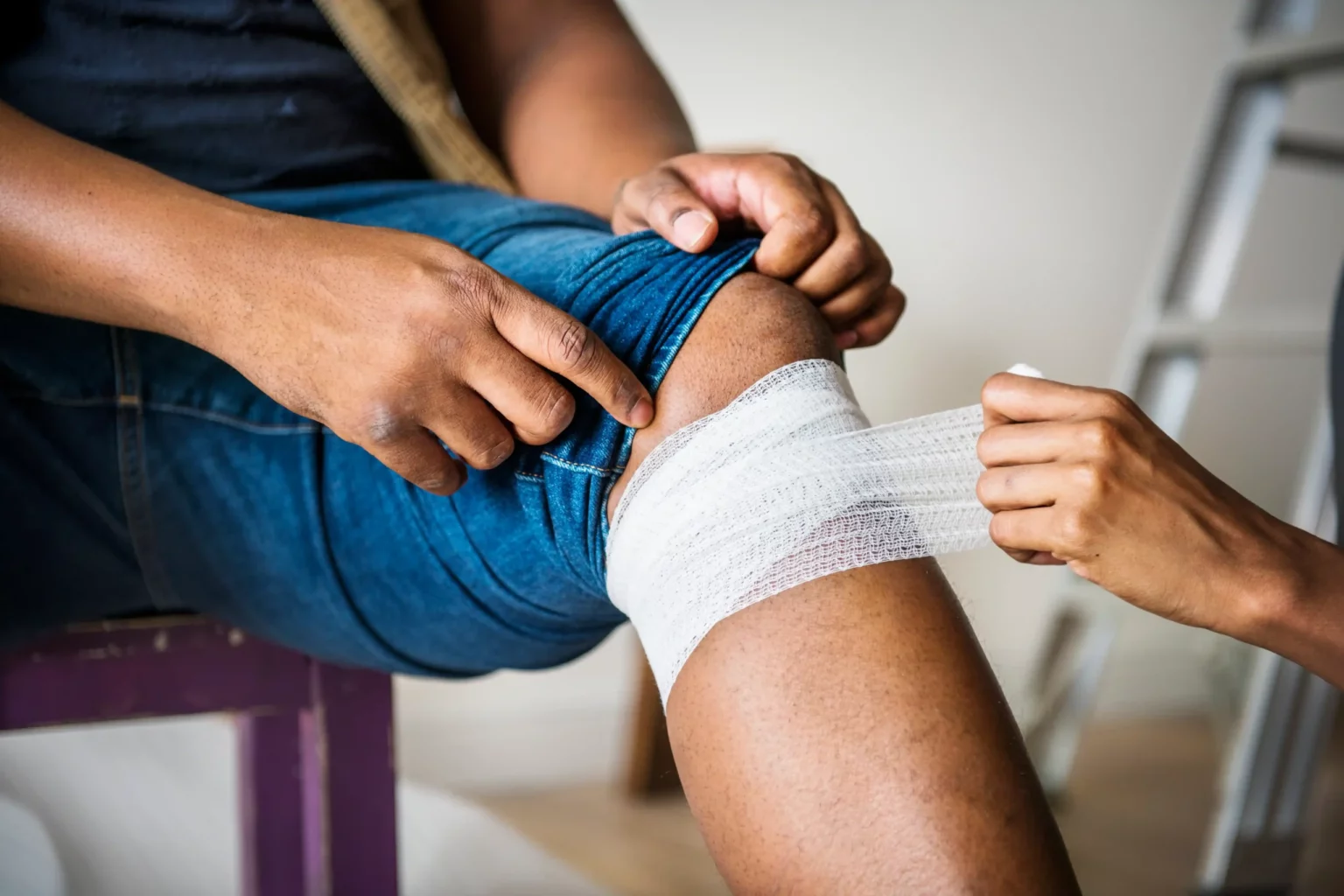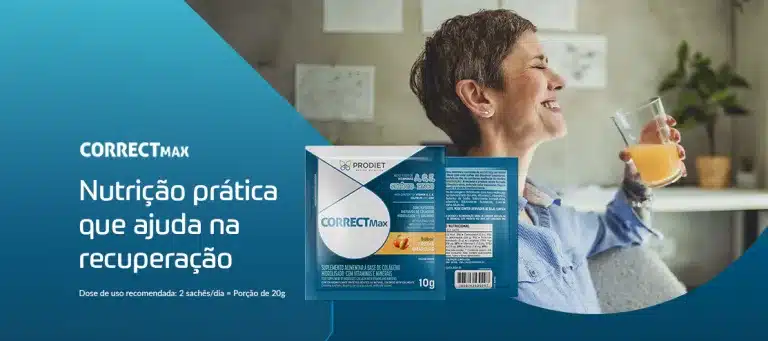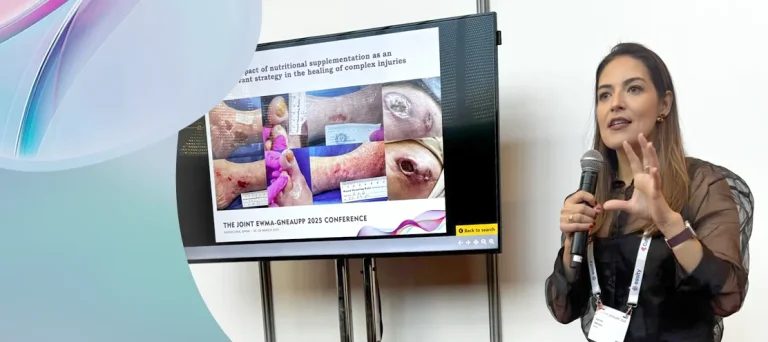Did you know that wound healing goes far beyond topical care? The key to a quick and efficient recovery is directly linked to what you put on your plate!
Let's start by saying that you can't expect wounds to heal well when you're suffering from a nutritional deficiency, as the immune system suffers the consequences and the quality and production of repair tissue decreases.
A balanced diet rich in specific nutrients can speed up the healing process, strengthening the body and preventing complications. Want to find out which foods can make a difference to your recovery or that of those you care for?
Read on and learn about the essential nutrients that will change the way you look at nutrition and skin health!
Lesions that are difficult to heal
Lesions that are difficult to heal are wounds that, due to various factors, do not follow the normal tissue repair process and remain open for long periods. These include pressure injuries and diabetic foot ulcers, each with specific characteristics and challenges that require special attention and care.
Pressure injury
Pressure injuries, also known as bedsores or pressure ulcers, are a significant health problem, especially in bedridden patients or those with reduced mobility.
They occur due to prolonged pressure on the skin, which compromises blood circulation and leads to tissue damage.
To better understand the severity and the care required, these injuries are classified into different stages:
Pressure Injury Stage 1: intact skin with erythema (redness) that does not turn white
In stage 1, the skin is still intact, but has an erythema that doesn't go away when pressed. This is the earliest sign of a pressure injury and indicates that there is an interruption in blood flow. The affected area can be painful, firm, warmer or colder than the surrounding skin. It is essential to intervene quickly at this stage to prevent progression.
Imagine a bedridden elderly person who cannot move easily. If frequent changes of position are not made, the skin in the areas of greatest pressure, such as the heels and hips, can begin to show signs of persistent erythema.
Pressure Injury Stage 2: partial-thickness skin loss with exposure of the dermis
In stage 2, there is a partial loss of skin thickness, affecting the epidermis and possibly the dermis. The injured area may appear as a ruptured blister or pinkish-red sore, with no devitalized tissue. This stage is more painful and requires special care to avoid infection.
An example would be a patient with limited mobility develops a blister on the ankle due to constant friction from the bed. When the blister ruptures, it exposes the underlying dermis, requiring appropriate dressings to prevent infection.
Pressure Injury Stage 3: full thickness skin loss
In stage 3, the lesion involves total loss of skin thickness, with exposure of the subcutaneous tissue. The wound bed may show visible fatty tissue, but there is no exposure of bones, muscles or tendons. Devitalized tissue (sputum) or exudate (secretion) may be present.
A person with complete immobilization can develop an ulcer, where the continuous pressure causes a deep wound that reaches the subcutaneous tissue. This wound requires debridement and intensive care to promote healing.
Pressure injury Stage 4: full thickness skin loss and tissue loss
This is the most serious stage, where there is total loss of skin and tissue thickness, with exposure of bones, muscles or tendons. The risk of infection is extremely high, and healing is complex and prolonged. It requires advanced medical intervention, including possible skin grafts.
A patient with a pressure injury to the heel that has not been treated properly can progress to stage 4, exposing the heel bone. This situation often requires surgery and specialized care.
Unclassifiable Pressure Injury: full thickness skin loss and non-visible tissue loss
These lesions involve total loss of skin thickness, but the base of the wound is covered by eschar (dead tissue) or devitalized tissue, making it impossible to fully assess the depth. Removal of the devitalized tissue is necessary to determine the extent of the injury.
Example: A patient presents with a wound covered in a dark crust on the hip. Only after removing this dead tissue is it possible to assess the true depth and extent of the lesion.
Deep Tissue Pressure Injury: dark red, brown or purple discoloration, persistent and not whitening
These lesions are characterized by persistent dark red, brown or purple discoloration, indicating deep tissue damage under the intact skin. They can quickly progress to a more serious stage if not treated promptly.
Medical Device Related Pressure Injury
Pressure injuries related to medical devices occur when a medical device applied to the patient exerts continuous pressure on the skin or underlying tissues. Common examples include oxygen masks, feeding tubes and catheters. These injuries are particularly challenging because the devices are often essential to the patient's treatment, making them difficult to remove or reposition.
If an injury develops, it is crucial to minimize the use of the device in the affected area, if possible, and to adopt pressure relief measures, in addition to following standard wound care practices.
Pressure Injury to Mucous Membranes
Pressure injuries to mucous membranes occur on internal body surfaces lined with mucous, such as the mouth, nostrils and esophagus. These injuries are often associated with the use of medical devices such as endotracheal tubes, nasogastric tubes and other equipment inserted through the mucous membranes.
It involves rigorous care of oral hygiene or the affected site, pressure relief, and in some cases, replacing the device or changing the insertion technique.
Diabetic foot
Diabetic foot is a common complication in patients with diabetes mellitus, characterized by the formation of foot ulcers due to diabetic neuropathy (nerve damage) and peripheral vascular disease (poor circulation).
These ulcers are particularly worrying because neuropathy reduces sensitivity in the feet, allowing small wounds to go unnoticed and develop into serious infections.
How can proper nutrition influence wound healing?
Proper nutrition plays a fundamental role in wound healing, directly influencing the body's ability to repair damaged tissue.
In other words, you can't expect wounds to heal well when you're living with a nutritional deficiency, as the immune system suffers the consequences and the quality and production of repair tissue decreases.
A balanced diet provides the body with the essential nutrients needed for each stage of the healing process, from initial inflammation to tissue remodeling. In addition, a nutrient-rich diet strengthens the immune system, preventing infections and promoting faster and more effective recovery.
Main nutrients involved in the healing process
In addition to mechanical care and hygiene, nutrition plays a vital role in the prevention and treatment of injuries. Adequate intake of essential nutrients, such as proteins, vitamins A, C and E, and minerals such as zinc and selenium, is crucial for the integrity of the skin and mucous membranes, as well as for efficient healing. Let's find out more:
Proteins
Proteins are the building blocks of the body and play a vital role in wound healing. They are necessary for the synthesis of collagen and other components of connective tissue. Foods such as lean meats, eggs, legumes and dairy products are excellent sources of protein.
Arginine
Arginine is an amino acid that stimulates collagen production and improves blood flow to injured areas, speeding up the healing process. It can be found in foods such as chicken meat, fish, nuts and seeds.
Vitamin A
Vitamin A is crucial for cell proliferation and the formation of epithelial tissue. It also has anti-inflammatory properties that help reduce the risk of infection. Foods rich in vitamin A include carrots, pumpkin, spinach and liver.
Vitamin C
Vitamin C is essential for collagen synthesis and immune function. It also acts as an antioxidant, protecting cells from free radical damage. Citrus fruits, strawberries, kiwis and peppers are great sources of vitamin C.
Vitamin E
Vitamin E is known for its antioxidant and anti-inflammatory properties, which help protect cells during the healing process. Nuts, seeds, spinach and broccoli are good sources of this vitamin.
Zinc
Zinc plays a crucial role in the synthesis of proteins and collagen, as well as strengthening the immune system. It is found in meat, seafood, nuts and legumes.
Selenium
Selenium is a mineral with antioxidant properties that help protect cells from oxidative stress during healing. Foods rich in selenium include Brazil nuts, seafood and eggs.
Are there foods that can damage healing?
Yes, some foods can damage the wound healing process, especially when consumed in excess or under certain conditions. Foods high in saturated fats, such as fried foods, processed foods and fast food, can increase inflammation in the body. This not only slows down healing, but also increases the risk of complications, such as infections.
In addition, excessive consumption of refined sugar and foods with a high glycemic index can interfere with blood glucose levels, hindering healing and favoring bacterial proliferation in the affected area.
Another important point is foods high in sodium and preservatives, which are present in many industrialized foods. Excessive consumption of these ingredients can lead to fluid retention and increased swelling, which can compromise blood circulation in the wound area and impair healing.
It is therefore advisable to avoid and/or reduce the consumption of these foods during the wound recovery process.
In addition to the foods mentioned above, alcohol can also negatively affect healing. Excessive alcohol consumption can compromise the immune system and increase recovery time, as well as increasing the risk of post-operative complications.
In conclusion, nutrition plays a fundamental role in wound healing, directly influencing the speed and effectiveness of the recovery process. Opting for a diet rich in essential nutrients, such as proteins, vitamins and minerals, is crucial for promoting a proper immune response and stimulating the regeneration of damaged tissues.
Avoiding foods that can impair healing, such as those rich in saturated fats and refined sugars, is equally important.
Prioritize healthy eating to aid healing more quickly and efficiently!
References
GUO, S.; DIPIETRO, L.a.. Factors Affecting Wound Healing. Journal Of Dental Research, [s.l.], v. 89, n. 3, p. 219-229, feb. 5, 2010. SAGE Publications.
Waitzberg, Dan L. Oral, enteral and parenteral nutrition in clinical practice. 5.ed. Rio de Janeiro. Atheneu, 2017.
ZENG, Ruijie; LIN, Chuangqiang; LIN, Zehuo; CHEN, Hong; LU, Weiye; LIN, Changmin; LI, Haihong. Approaches to cutaneous wound healing: basics and future directions. : basics and future directions. Cell And Tissue Research, [s.l.], v. 374, n. 2, p. 217-232, 10 Apr. 2018. Springer Science and Business Media LLC. http://dx.doi.org/10.1007/s00441-018-2830-1.
DINIZ, Andrea Goulart. Relevance of nutrition in the wound healing process. 2013. 53 f. Monograph (Specialization) - Primary Care in Family Health Course, Universidade Federal de Minas Gerais, Logoa Santa, MG, 2013.
MORAES, Juliano Teixeira et al. Concept and classification of pressure injury: update of the national pressure ulcer advisory panel. Revista de Enfermagem do Centro-Oeste Mineiro, [S.L.], v. 6, n. 2, p. 2292-2306, 29 jun. 2016.
LEAL, E. C.. Wound healing: the physiological and the pathological. Revista Portuguesa de Diabetes, Coimbra, v. 3, n. 9, p. 133-143, Sep. 2014.






